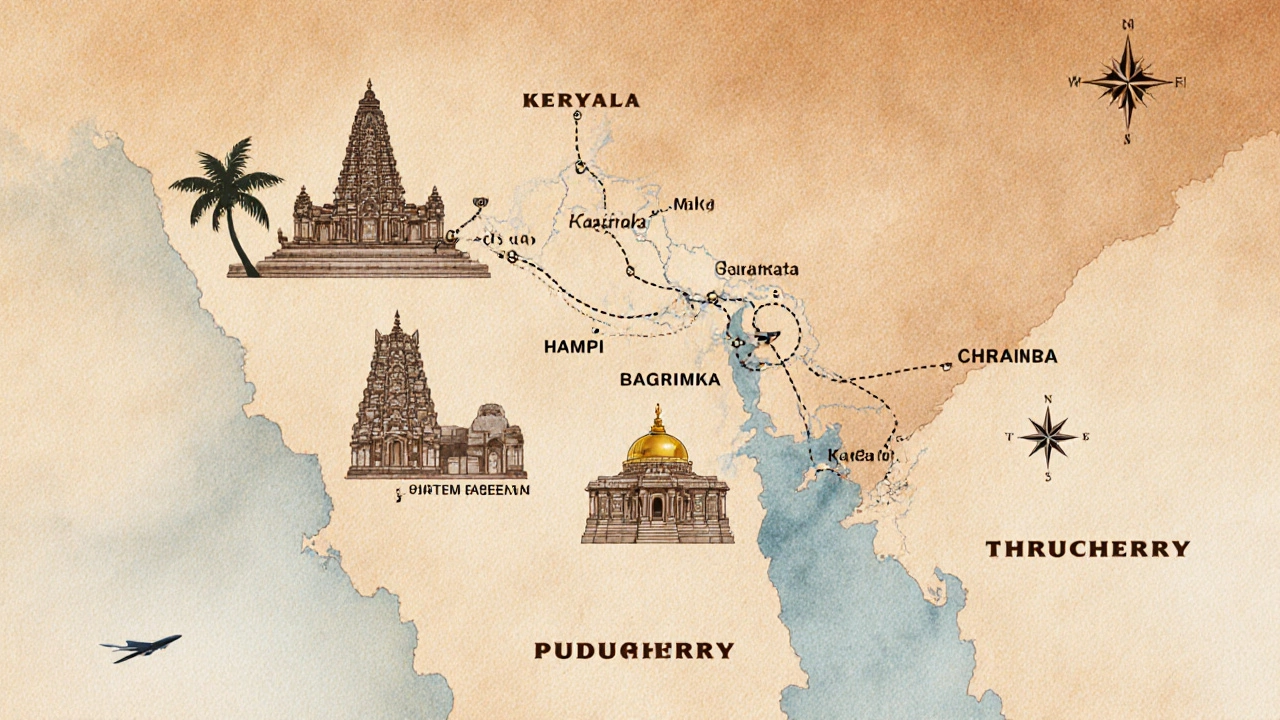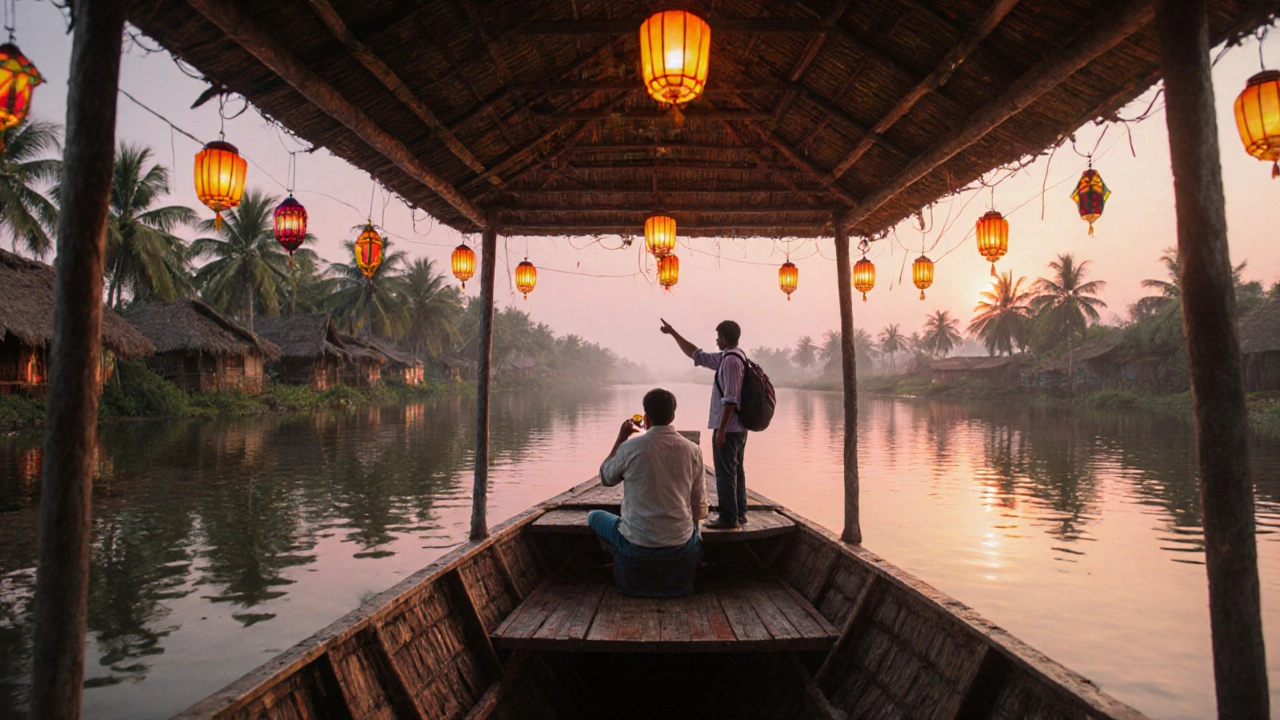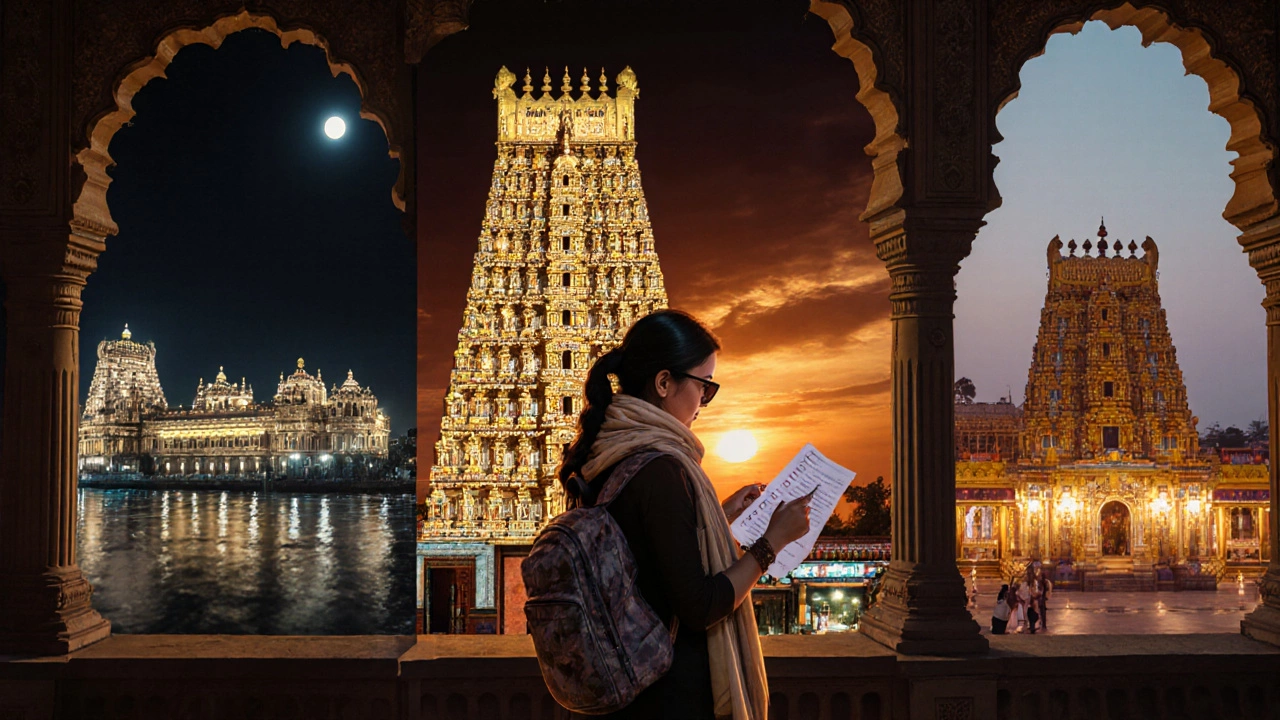How to Plan a South Indian Trip: A Step‑By‑Step Guide
 Oct, 17 2025
Oct, 17 2025
South India Budget Calculator
Plan Your South India Trip Budget
Estimate your travel costs based on duration, travel style, and daily spending preferences
Your Estimated Budget
Based on article data from How to Plan a South Indian Trip: A Step‑By‑Step Guide
Cost Breakdown
| Accommodation | |
| Food | |
| Transport | |
| Entry Fees & Tours |
Planning a South India trip is a blend of beach vibes, temple awe, spice‑laden food, and rolling hills. If you’re staring at a map and wondering where to start, this guide walks you through every decision - from picking the best month to setting a daily budget - so you can hit the road with confidence.
Quick Takeaways
- Travel window: October-March gives pleasant weather across all states.
- Core states: Kerala, TamilNadu, Karnataka, AndhraPradesh - each offers a distinct flavor.
- Transport mix: Fly into Kochi or Chennai, then use Indian Railways or state buses for intra‑state hops.
- Must‑see highlights: backwaters of Alappuzha, Mysore Palace, Hampi ruins, Tirupati temple.
- Budget tip: Book sleeper class trains and guest‑house rooms early for up to 40% savings.
When to Go: Picking the Right Season
South India sits just above the tropic of Cancer, so it enjoys three main climate phases: hot summer, monsoon, and cool winter. Your choice hinges on what you want to do.
| Season | Typical Weather | Best Activities | Travel Tips |
|---|---|---|---|
| Winter (Oct‑Mar) | 15‑30°C, dry | Beach, temple tours, hill‑station hikes | Pack light layers; peak season - book early |
| Summer (Apr‑Jun) | 30‑40°C, dry inland | Coastal swims, early‑morning trekking | Stay hydrated; avoid midday outdoors |
| Monsoon (Jul‑Sep) | Heavy rain, 25‑30°C | Backwater cruises, lush green scenery | Carry waterproof gear; expect travel delays |
For most first‑time visitors, the South India travel window of October to March offers comfortable temperatures and clear skies, making it the safest bet.
Choosing Your Core Regions
South India comprises four big states and one union territory. Each region has a signature draw, so decide what excites you most.
Kerala is a coastal haven famous for its backwaters, Ayurvedic spas, and spice‑filled cuisine. If you love serene waterways and lush greenery, allocate at least three days to the Kerala backwaters and FortKochi.
TamilNadu blends bustling metros like Chennai with ancient temples such as Meenakshi in Madurai. A mix of city life and heritage makes it perfect for a five‑day stretch.
Karnataka offers everything from Bangalore’s tech vibe to the royal splendor of Mysore. Don’t miss the UNESCO‑listed Hampi ruins if history fascinates you.
AndhraPradesh showcases pristine beaches at Visakhapatnam and the sacred Tirupati temple. It’s a great add‑on for spiritual travelers.
Mapping Out Your Itinerary
Below is a sample 12‑day itinerary that balances travel time with experiences. Feel free to trim or extend based on your schedule.
- Day1‑2: Chennai (TamilNadu) - Arrive, explore Marina Beach, Kapaleeshwarar Temple, and the vibrant markets.
- Day3‑4: Pondicherry (Union Territory) - French‑colonial charm, Auroville, and seaside cafés.
- Day5‑7: Kerala Backwaters (Kerala) - Fly to Kochi, then board a houseboat from Alappuzha for a two‑night cruise.
- Day8‑9: Mysore (Karnataka) - Catch a night train to Mysore, visit Mysore Palace, and stroll the Brindavan Gardens.
- Day10‑11: Hampi (Karnataka) - Bus or hire a car to the ruins, spend sunrise and sunset at the iconic stone cliffs.
- Day12: Bengaluru (Karnataka) - End with a city tour, then depart.
Adjust the order if you land in a different gateway city - the key is to minimize back‑tracking.

Getting Around: Flights, Trains, and Buses
India’s transport network is massive but can feel chaotic. Here’s a quick rule‑of‑thumb:
- Flights: Use them for long hops (e.g., Chennai↔Kochi). Domestic carriers like IndiGo and SpiceJet keep fares low.
- Indian Railways: The backbone for inter‑state travel. Book sleeper class for comfort and price; AC 3‑tier for extra privacy.
- State Buses: Karnataka State Road Transport Corporation (KSRTC) and Kerala State Road Transport Corporation (KSRTC) run reliable services between towns.
- Auto‑rickshaws & App‑based cabs: Ideal for short city trips. Always agree on fare or use Uber/Ola when available.
To avoid last‑minute hassles, reserve train tickets via the IRCTC portal at least 30 days ahead, especially for popular routes like Chennai‑Bengaluru.
Where to Stay: From Guesthouses to Luxury Resorts
Accommodation choices reflect budget and experience.
- Budget: Guesthouses and homestays (often listed on Airbnb or Booking.com) cost $10‑$20 per night and provide a chance to eat home‑cooked meals.
- Mid‑range: Boutique hotels ($30‑$60) offer private bathrooms and sometimes a pool.
- Luxury: Resorts along the Kerala coast (e.g., Kumarakom Lake Resort) start at $120 and include spa treatments and private boat rides.
Tip: Stay at a homestay in Kerala’s village outskirts for an authentic spice garden tour.
Must‑See Highlights by State
These are the non‑negotiables that most travelers regret missing.
- Alappuzha Backwaters in Kerala - A houseboat cruise is the ultimate way to unwind.
- Meenakshi Amman Temple in Madurai, TamilNadu - Its towering gopurams sparkle at sunset.
- Hampi (Karnataka) - Explore the ruins of the Vijayanagara Empire, a UNESCO World Heritage site.
- Mysore Palace - A night illumination shows the palace in all its gold‑glitter.
- Tirupati Temple (AndhraPradesh) - One of the most visited pilgrimage sites; plan for early morning darshan.
Food, Culture, and What to Try
South Indian cuisine is a world of flavors. Here are three dishes you shouldn’t miss:
- Dosa - Thin rice‑and‑lentil crepe, typically served with coconut chutney and sambar.
- Hyderabadi Biryani - Aromatic rice layered with spiced chicken or mutton, a legacy of the Nizam’s court.
- Kerala Sadya - A banquet of vegetarian dishes served on a banana leaf during festivals.
Eat at local eateries (called "eats" or "mess") for the cheapest and most authentic meals. A plate of idli‑sambar will cost less than $1 in most towns.

Budget Planning: How Much to Expect
Below is a rough daily cost breakdown for a mid‑range traveler.
| Category | Low | Mid‑range | High |
|---|---|---|---|
| Accommodation | $10 | $35 | $150 |
| Food | $5 | $15 | $40 |
| Transport | $3 | $12 | $30 |
| Entry fees & tours | $2 | $8 | $20 |
For a 12‑day trip, a comfortable budget sits around $800‑$1,200 including flights from abroad.
Safety, Health, and Practical Tips
- Vaccinations: HepatitisA, Typhoid, and Tetanus are recommended.
- Water: Always drink bottled or filtered water. Avoid ice cubes unless you’re sure they’re from safe sources.
- Cash: Carry some Indian Rupees (₹) for small vendors; ATMs are common in cities but scarce in remote areas.
- Dress code: Modest clothing is advisable for temple visits - cover shoulders and knees.
- Connectivity: Buy a prepaid SIM (e.g., Jio or Airtel) at the airport for cheap data.
Final Checklist Before You Go
- Passport valid≥6months; obtain an Indian e‑Visa.
- Book flights to your first gateway city (Chennai, Bengaluru, or Kochi).
- Reserve sleeper class trains via IRCTC (or use a reliable agent).
- Pack lightweight clothing, a rain jacket (if traveling in monsoon), and a pair of comfortable walking shoes.
- Download offline maps of each city (Google Maps offline packs work well).
- Print or save digital copies of hotel confirmations and train tickets.
Frequently Asked Questions
What is the best time of year for a South India road trip?
October to March offers dry weather and comfortable temperatures, making it ideal for both coastal drives and hill‑station visits.
Do I need a visa to travel to South India?
Most travelers require an Indian e‑Visa, which can be applied for online and is usually approved within a few days.
Is it safe to travel alone as a solo female in South India?
Yes, solo female travel is common. Stick to well‑lit areas, use reputable transport, and consider staying in women‑friendly hostels or homestays.
How far in advance should I book trains for a busy season?
Indian Railways opens bookings 120 days ahead. For popular routes like Chennai‑Bengaluru, aim to reserve tickets as soon as the window opens.
Can I use credit cards everywhere in South India?
Cards work in major hotels and malls, but many small eateries and markets prefer cash. Keep small notes handy for daily purchases.